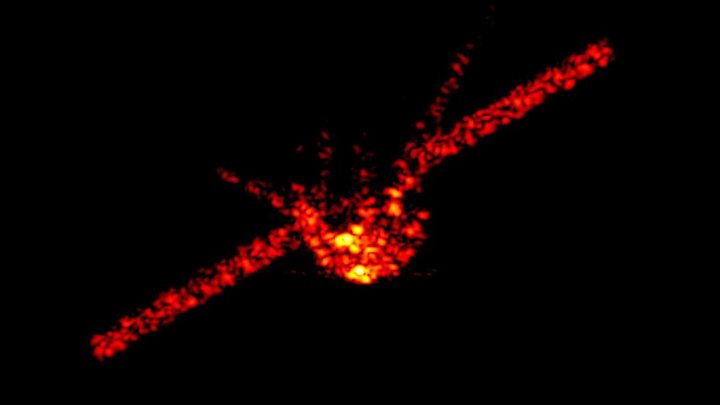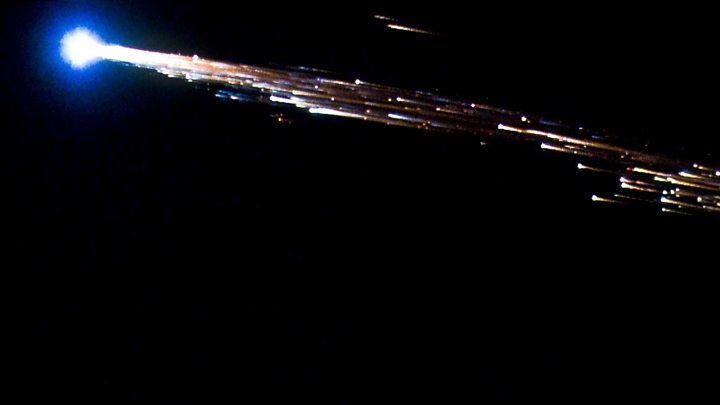China's space lab may make later return

Experts tracking China's defunct Tiangong-1 space lab say it could now fall to Earth later than thought.
The analysis had suggested the 10m-long, 8.5-tonne spacecraft would plunge into the Earth's atmosphere between midday Saturday and the afternoon of Sunday (GMT) - and it still could.
But the most recent assessment has extended the estimated window for re-entry.
It now goes out to the late evening of Sunday, 1 April.
The situation remains highly variable.
China lost all contact with, and control over, Tiangong in 2016.
When it does eventually dive back into the atmosphere, it will break up. However, the chances of any debris hitting a populated area on the ground are described as very slim.
"Given Tiangong-1 has a larger mass and is more robust, as it is pressurised, than many other space objects that return uncontrolled to Earth from space, it is the subject of a number of radar tracking campaigns," explained Richard Crowther, the UK Space Agency's chief engineer.
"The majority of the module can be expected to burn up during re-entry heating, with the greatest probability being that any surviving fragments will fall into the sea," he told BBC News.
- Precise knowledge of the re-entry time and location will come late
- Typically, only in the last hour or so are experts very confident
- Most of the module's components will burn up in the high atmosphere
- Its orbital path means any debris is restricted in where it can fall
- Perhaps 20-40% could survive to the surface - that's 1.5-3.5 tonnes
- The highest probability is that this material would hit the ocean
- Any debris path at the surface would be hundreds of km long
- Tiangong is the 50th most massive object to come back uncontrolled
Launched in 2011 and visited by six Chinese astronauts, Tiangong was supposed to have been de-orbited in a planned manner.
The intention was to use its thrusters to drive the vehicle towards a remote zone over the Southern Ocean. But all command links were abruptly lost in 2016, and now nothing can be done to direct the fall.
Tiangong is now brushing through the top of the atmosphere, which is dragging on the spacecraft and causing it to lose altitude rapidly.
- Big harpoon is 'solution to space junk'
- Space junk threatens Earth's future
- The place spacecraft go to die
Thirteen space agencies, under the leadership of the European Space Agency, are now following its path around the globe, modelling its behaviour.
This collective, known as the Inter-Agency Space Debris Coordination Committee (IADC), is trying to forecast the most likely time and place for the laboratory's final, destructive plunge.
The many uncertainties involved mean definitive statements can only be made close to the end of Tiangong's flight.

"A confidence of one hour is only reached about four hours beforehand. And one hour still means almost one revolution around the Earth," said Holger Krag, the head of Esa's space debris office. "But that's still good enough to exclude many countries and even some continents."
What can be said with certainty is that nothing will fall outside of 43 degrees from the equator, north or south.
This encompasses a region up to the Mediterranean and down to Tasmania, for example. It is governed by the inclination on which Tiangong was launched.
China has limited national tracking facilities around the globe and so had no choice but to keep the vessel on a reasonably tight equatorial path.
The International Space Station by contrast reaches 52 degrees north and south.
Tiangong means 'Heavenly Palace'
- The module was launched in 2011 to practise rendezvous and docking
- Two astronaut crews visited in Shenzhou capsules - in 2012 and 2013
- They included China's first female astronauts Liu Yang and Wang Yaping
- China plans a more permanent space station in the next decade
- It has developed a heavy-lift rocket, Long March 5, for the purpose
Although about 5.2 billion people live within the re-entry zone, most of it is ocean, which explains the high probability that any debris that survives to the surface will hit water.
Dr Krag said: "We know from similar events that on average between 20% and 40% of the initial mass has the chance to survive re-entry heating.
"We could apply this rule of thumb also to Tiangong, I believe, because typically the same amount of heat-resistant material in relative terms is onboard all spacecraft.
"So that would mean between 1.5 tonnes and 3.5 tonnes might be able to survive," he told BBC News.
The components that most often seem to avoid burning up in the atmosphere are tanks. These objects are interior to the spacecraft and so are protected for much of the descent.
But they are also made from steel, titanium or carbon-reinforced plastics and these materials are generally more resistant to high temperatures should they become exposed.
Tiangong is certainly on the large size for uncontrolled re-entry objects but it is far from being the biggest, historically.
The US space agency's Skylab was almost 80 tonnes in mass when it came back partially uncontrolled in 1979. Parts struck Western Australia but no-one on the ground was injured.
Nasa's Columbia shuttle would also have to be classed as an uncontrolled re-entry. Its mass was over 100 tonnes when it made its tragic return from orbit in 2003.
Again, no-one on the ground was hit as debris scattered through the US states of Texas and Louisiana.
The redoubtable cataloguer of space activity, Jonathan McDowell from the Harvard-Smithsonian Center for Astrophysics, reckons Tiangong is only the 50th most massive object to come back uncontrolled.
China is participating in the IADC campaign and is sharing some of its data.
The nation has since launched a second lab, Tiangong-2, which continues to be operational. It was visited by a re-fuelling freighter, Tianzhou-1, just last year.
The Tiangongs were put up to demonstrate orbital rendezvous and docking capabilities - to be testbeds to rehearse activities ahead of China's more permanent space station.
This facility, which is expected to comprise a large core module and two smaller ancillary modules, will be in service early next decade, the Asian nation says.
A new rocket, the Long March 5, was recently introduced to perform the heavy lifting that will be required to get the core module in orbit.
Jonathan.Amos-INTERNET@bbc.co.uk and follow me on Twitter: @BBCAmos